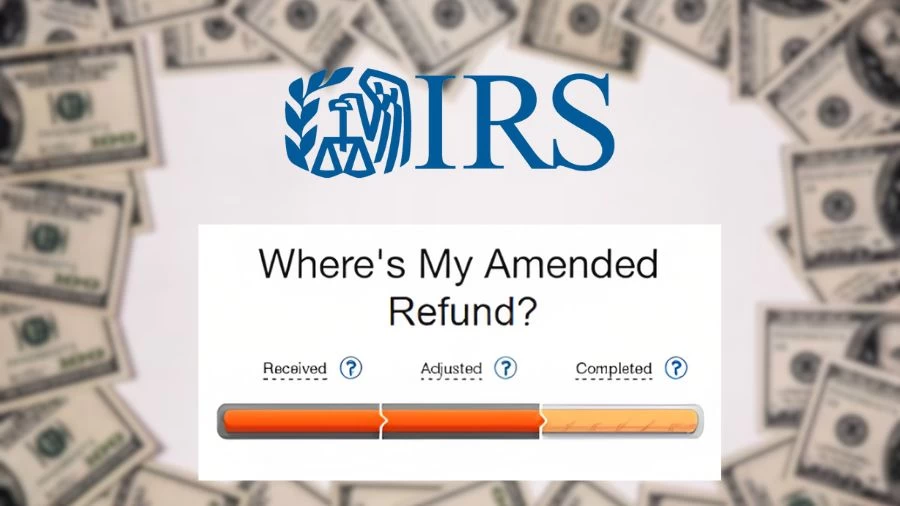
Where's My Amended Return? What’s the Status of My Amended Return?
Track the progress of your amended tax return by providing essential details such as your Social Security number, date of birth, and ZIP code through the user-friendly online tool or by calling the amended return hotline at 866-464-2050.
by Kowsalya
Published Aug 26, 2023 | Updated Aug 26, 2023 | 📖 11 min read
On This Page
- Where's My Amended Return?
- What’s the Status of My Amended Return?
- Why is My Amended Return Taking So Long?
- What is an Amended Return?
- How to Amend a Tax Return?
- Who Should File an Amended Return?
- How Long Does Amended Return Take?
- What Are the Pros and Cons of Amended Tax Return?
- When to File an Amended Return?
Where's My Amended Return?
To keep tabs on the status of your modified tax return, you have two options: utilizing the "Where's My Amended Return?" online tool or contacting the amended return hotline at 866-464-2050. It's worth noting that both of these resources are available in both English and Spanish, catering to a wider range of users.
In order to obtain an update on your return's progress, you'll need to furnish some fundamental information to verify your identity. Prior to accessing the Where's My Amended Return tool or making the call to the IRS, ensure you have the following details on hand:
- Your Social Security number or individual tax ID number.
- Your date of birth.
- Your ZIP code.
These essential pieces of information are crucial for the process of retrieving any amended returns you've filed for taxes over the past three years. It's important to bear in mind that the system for checking amended returns is distinct from the IRS's online "Where's My Refund" service, which is used to monitor the status of regular tax refunds.
To conveniently access the IRS' amended return tracker, simply click on the button provided below. This user-friendly tool facilitates the monitoring of your modified tax return progress in a hassle-free manner.
What’s the Status of My Amended Return?
After successfully locating your return within the system, the IRS will provide you with a concise description of its current status. Below is a brief rundown of the potential outcomes you might encounter and their implications:
- Your Amended Return is Received: If the IRS notifies you that your return has been received, it means they have received your submission but have not yet finalized their assessment. Consequently, you might need to exercise patience as the processing phase may take approximately 20 weeks or more to reach completion.
- Your Amended Return is Adjusted: If your return is labeled as "adjusted," this indicates that the IRS has thoroughly reviewed your amended tax return and made necessary modifications to your account. These adjustments could lead to various outcomes, including receiving a refund, having a balance due, or encountering no changes to your tax liability, as clarified by the IRS.
- Your Amended Return is Completed: Once your amended return garners the status of "completed," it signifies that the IRS has concluded its meticulous examination of the documents you've submitted. Any pertinent information regarding the processing of your return will be dispatched to you via mail, according to the IRS guidelines.
It's important to recognize that these statuses represent distinct stages in the review and processing of your amended return. Each status carries its own significance, ranging from initial acknowledgment to in-depth evaluation and finalization. Keeping track of these updates can offer insight into the progression of your amended tax return and the ensuing actions or communications you can anticipate from the IRS.
Why is My Amended Return Taking So Long?
On occasion, complications with your return can impede the normal pace at which the IRS assesses your amended tax return, leading to potential delays in the overall process. Several factors that could contribute to such delays, as outlined by the IRS, include:
- Errors, Incompleteness, or Lack of Signature: Should your amended return contain errors, be incomplete, or lack the necessary signature, the processing could be hindered. Rectifying these issues is essential to ensure a smooth review.
- Request for Additional Information: If the IRS deems more information necessary, your return might be returned to you for supplementation. This exchange of information could extend the processing timeline.
- Inclusion of Form 8379 - Injured Spouse Allocation: The presence of Form 8379, which pertains to Injured Spouse Allocation, can introduce complexities and consequently elongate the review procedure.
- Identity Theft or Fraud Concerns: If there are suspicions of identity theft or fraudulent activities linked to your amended return, addressing these issues could extend the timeline as the IRS ensures accuracy and security.
- Specialized Review Requirements: Cases requiring assessment by specialized IRS sections, such as the bankruptcy division, may undergo a more extended evaluation process, necessitating additional time. The IRS will communicate if such circumstances arise.
It's noteworthy that the past few years have witnessed a general trend of slower processing times. Formerly, standard processing spanned 16 weeks, but presently, the IRS acknowledges that the process may exceed 20 weeks. This broader timeframe is indicative of the ongoing challenges in the processing landscape. In the event of delays or specific requirements, maintaining open communication with the IRS and addressing any outstanding matters promptly can help facilitate the resolution of these issues.
What is an Amended Return?
An amended return is a document submitted to rectify errors in a prior year's tax return. Its purpose is to fix mistakes and potentially achieve a more favorable tax outcome, such as obtaining a refund. For instance, individuals might opt for an amended return when they have inaccurately stated their earnings or tax credits. It's worth noting that mathematical miscalculations don't necessitate amended returns, as the IRS automatically adjusts such errors during the tax return processing.
The designated form for initiating amended returns is Form 1040-X, conveniently accessible on the official IRS website. Modifications in filing status, adjustments to the count of claimed dependents, erroneous tax credit and deduction claims, and inaccurately recorded income are all grounds for individuals to initiate an amended return. A specific timeframe applies to the issuance of tax refund checks, with a statute of limitations set at three years.
How to Amend a Tax Return?
Form 1040-X is structured with three distinct columns: A, B, and C. Within column A, individuals are required to input the precise value that was initially reported in the original or latest-amended tax form. In contrast, column C is designated for the insertion of the adjusted or accurate figure that should replace the original entry. The disparity between the values in columns A and C is meticulously captured in column B.
The nature of the adjustments executed on a tax return will ultimately lead to one of three outcomes: a reimbursement of excess taxes paid, an outstanding balance to be settled, or an absence of changes in the overall tax amount. This procedure ensures that the corrections made align with the appropriate financial implications.
Furthermore, Form 1040-X allocates a dedicated section on its reverse side where taxpayers are expected to provide comprehensive clarification for each alteration. This entails a thorough articulation of the alterations being undertaken and a transparent exposition of the rationale underpinning each modification. This comprehensive explication offers a clear and complete understanding of the adjustments made in the tax return process.
Who Should File an Amended Return?
Every year, all taxpayers are obligated to complete their tax filing for the preceding tax year. Situations may arise where taxpayers realize errors in their tax forms or experience changes in their circumstances after submitting their return, which has been acknowledged by the government. To address these scenarios, the Internal Revenue Service (IRS) offers a solution in the form of an amended return, facilitated through Form 1040-X, accessible on the official IRS website.
It's noteworthy that the option to file an amended tax return remains available even after the official tax filing deadline for the respective tax year has elapsed. Notably, not all errors necessitate the use of the amendment form. The IRS is equipped to identify and rectify mathematical inaccuracies, such as computational errors, during the initial processing of the tax return. In such cases, any owed refunds are adjusted accordingly, while any additional tax liabilities are communicated to the taxpayer for settlement.
Should an individual neglect to include a mandated form or schedule in their initial tax return submission, the IRS takes action by sending a correspondence requesting the submission of the missing information. This communication outlines the necessary steps for the individual to mail the required documents to one of the IRS offices, thereby ensuring the completeness and accuracy of the tax return.
How Long Does Amended Return Take?
As per the Internal Revenue Service (IRS), the visibility of an amended return within their system typically takes about 3 weeks. The processing phase for these amended returns has a baseline of 16 weeks. It's noteworthy, though, that the ongoing pandemic has led to an extension of processing time, now spanning beyond 6 months.
This elongated period directly stems from the exceptional circumstances brought on by the pandemic, which have significantly impacted operational capacities. Consequently, the usual processing duration for amended tax returns has been unavoidably prolonged, reflecting the challenges posed by the current global situation.
What Are the Pros and Cons of Amended Tax Return?
Pros :
- Error Rectification: The amended tax return offers a valuable opportunity to rectify errors that might have occurred in the initial filing, ensuring accurate reporting of financial information.
- Reclaim Unclaimed Refunds: If you were owed a refund but didn't initially claim it, the amended return allows you to retrieve the rightfully owed refund even if you hadn't requested it in your initial filing.
- Adapting to Changed Circumstances: Life is dynamic, and circumstances can change after you've filed your original return. The amended return enables you to account for these changes, ensuring your tax information remains up-to-date and accurate.
Cons :
- Limited Electronic Filing: Not all tax years permit electronic filing of Form 1040-X. This can potentially create an inconvenience, as electronic filing is often faster and more streamlined compared to paper filing.
- Extended Processing Time: Amended returns typically involve a longer processing period, potentially spanning 16 weeks or more. This extended timeframe might test your patience, especially if you're awaiting a refund or resolution.
- Refund Collection Window: The Internal Revenue Service imposes a time limit on collecting tax refunds through amended returns. This window is restricted to a three-year span, beyond which refunds might not be recoverable.
Amending a tax return offers the advantages of error correction, refund reclamation, and adaptability to changing circumstances. However, the process might be hindered by limited electronic filing options and a protracted processing period. Additionally, it's crucial to be mindful of the three-year timeframe for collecting refunds through amended returns.
When to File an Amended Return?
A taxpayer is required to initiate the process of amending their tax return if:
- Change in Filing Status: If the taxpayer's filing status for the tax year has undergone a change or was initially recorded inaccurately, an amended return is necessary. For instance, an individual who filed as single but got married on the last day of the tax year must correct their filing status to reflect the appropriate married options: either filing jointly (MFJ) or separately (MFS).
- Dependent Adjustments: Inaccuracies in the number of claimed dependents call for an amended return. This applies both when additional dependents need to be claimed or when previously claimed dependents must be removed. For example, a couple welcoming a baby in January, after they filed their taxes for the prior year, cannot include that newborn in the previous year's tax return.
- Incorrect Tax Credits and Deductions: Instances where tax credits or deductions were wrongly claimed or omitted require corrective action. Taxpayers may identify missed credits or deductions and file an amended return to accurately account for them.
- Inaccurate Income Reporting: If additional tax-related documents, like Form 1099 or K-1, arrive after the tax deadline, taxpayers can file an amended return to incorporate the newly received income information.
- Legislative Changes in Deductibility: Adjustments to the deductibility of specific expenses prompted by legislative changes necessitate amended returns. For instance, the extension of the deduction for private mortgage insurance (PMI) through legislation, impacting multiple tax years, requires taxpayers to amend their returns to accommodate the updated deduction rules.
- Tax Relief due to Natural Disasters: When taxpayers experience alterations in their tax liability due to tax relief offered after a natural disaster, they might need to file an amended return. Natural disasters occurring late in the tax year can create situations where tax relief legislation is finalized after the standard tax season window.
- Reassessment of Owed Taxes: If a taxpayer realizes they owe more taxes than initially paid to the government, they can avoid penalties by submitting an amended return to rectify the discrepancy and settle the owed amount.
The circumstances that mandate an amended return include changes in filing status, adjustments related to dependents, errors in tax credits and deductions, incorrect income reporting, legislative alterations impacting deductions, tax relief due to natural disasters, and the realization of owed taxes. These scenarios highlight the importance of accuracy and compliance in the tax reporting process.
Where's My Amended Return - FAQs
1. What is "Where's My Amended Return?"
"Where's My Amended Return?" is an online tool provided by the IRS that allows taxpayers to track the status and progress of their filed amended tax returns.
2. How do I access the tool?
You can access the "Where's My Amended Return?" tool on the IRS website by clicking on the provided link or by visiting the official IRS website and searching for the tool.
3. What information do I need to use this tool?
To use the tool, you'll need to provide your Social Security number or individual tax ID number, your date of birth, and your ZIP code. These details are used to verify your identity.
4. Can I use this tool for all types of tax returns?
No, this tool is specifically designed for tracking the progress of amended tax returns that you have filed in the past three years. It is not meant for tracking the status of regular tax refunds.
5. Is the tool available in languages other than English?
Yes, the tool is available in both English and Spanish, catering to a wider range of users who prefer either language for their communication with the IRS.




